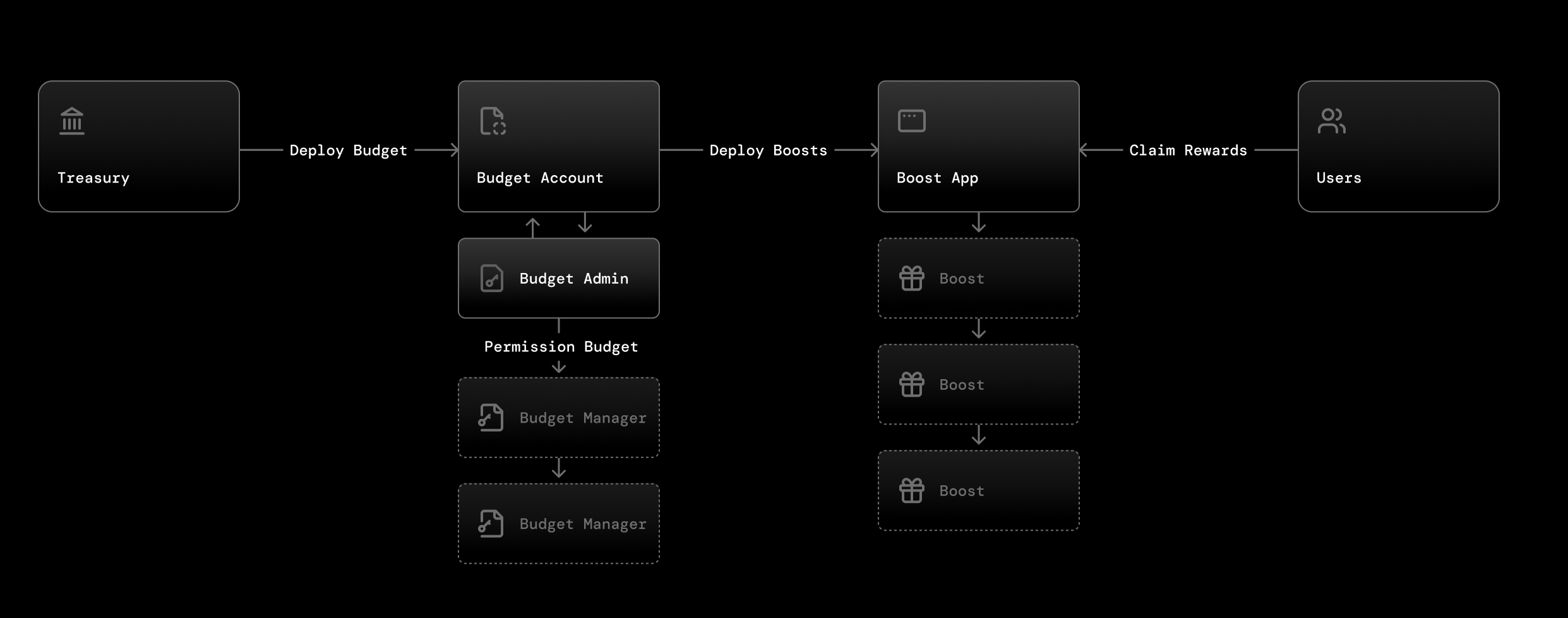
High Level Overview of Boost V2
Components
- User: The end-user interacting with the system.
- ExternalContract: The smart contract with which the user interacts to perform the incentivized action.
- BackendValidator: An off-chain component that validates the user’s action.
- Core: The central smart contract of the Boost protocol.
- SignerValidator: An on-chain component that verifies the proof of the user’s action.
Process Flow
-
Action Execution:
- The User executes an action on the ExternalContract.
- This action is the behavior that Boost aims to incentivize.
-
Off-chain Validation:
- The BackendValidator observes and validates the action off-chain.
- This allows for complex validation logic without incurring high gas costs.
-
Signature Generation:
- Upon successful validation, the BackendValidator generates a cryptographic signature.
- This signature serves as a proof that the user performed the specified action.
-
Signature Submission:
- The User submits the signature to the Core contract.
- This step initiates the on-chain portion of the claiming process.

-
On-chain Verification:
- The Core contract calls the SignerValidator with the provided signature.
- The SignerValidator uses EIP-712 signature validation to verify the proof.
- EIP-712 provides a secure method for signing and verifying structured data.
-
Reward Distribution:
- If the signature is valid, the Core contract distributes the incentive to the User.
Choosing a Reward
When setting up a Boost, it’s crucial to choose an appropriate reward structure that aligns with your project’s goals and tokenomics. Here are some considerations:-
Token Type:
- Native tokens (e.g., ETH)
- Project-specific tokens
- Stablecoins (e.g., USDC, DAI)
-
Reward Amount:
- Fixed amount per action
- Percentage-based rewards
- Tiered rewards based on action value or user status
-
Reward Frequency:
- Immediate distribution upon action completion
- Periodic distributions (e.g., daily, weekly)
- Milestone-based rewards
-
Reward Caps:
- Per-user caps to prevent exploitation
- Total reward caps for budget control
- Time-based caps (e.g., daily limits)
-
Vesting or Lock-up Periods:
- Immediate availability
- Gradual vesting to encourage long-term engagement
- Lock-up periods for larger rewards
- The perceived value of the incentivized action
- Your project’s token supply and inflation rate
- User behavior and motivation
- Regulatory compliance and tax implications
Key Improvements in V2
- Flexibility: The architecture allows for incentivizing actions on any external contract, greatly expanding the use cases for Boost.
- Gas Efficiency: By moving complex validation off-chain and only verifying a compact signature on-chain, gas costs are significantly reduced.
- Security: The use of EIP-712 for structured data signing ensures that the proofs are secure and tamper-resistant.
- Scalability: The off-chain validation allows for handling complex conditions and high volumes of actions without congesting the blockchain.
- Modularity: The separation of concerns between different components (ExternalContract, BackendValidator, Core, SignerValidator) allows for easier upgrades and maintenance.
How it works
Boost V2 offers a comprehensive suite of features for deploying, managing, and interacting with on-chain incentives. Here’s an overview of key processes:- Deploying Boosts Learn how to set up and deploy new Boost incentive programs.
- Claiming Rewards Explore the user journey for interacting with a Boost and claiming earned rewards.
- Use Cases Discover various applications and scenarios where Boost V2 can be effectively implemented.